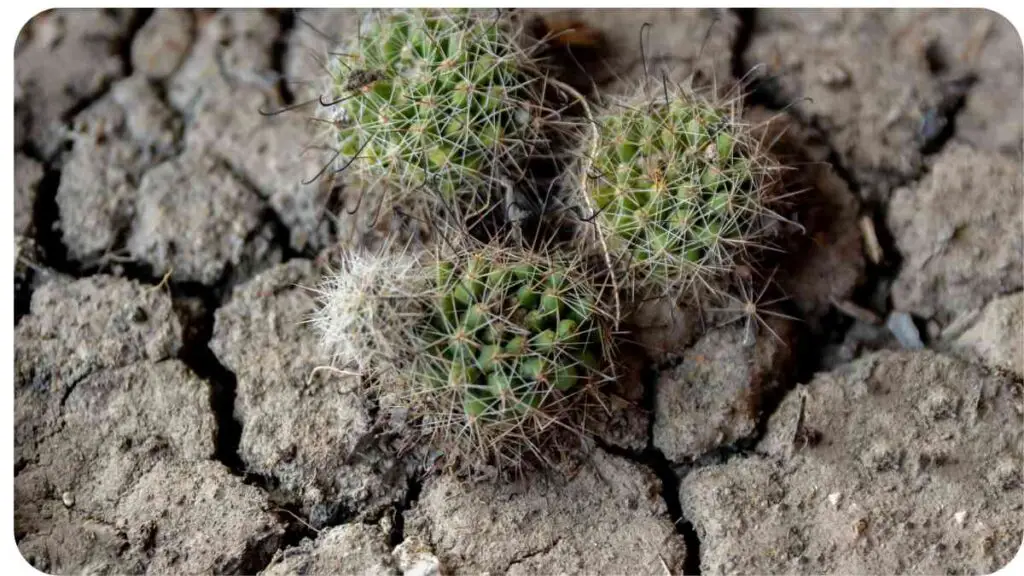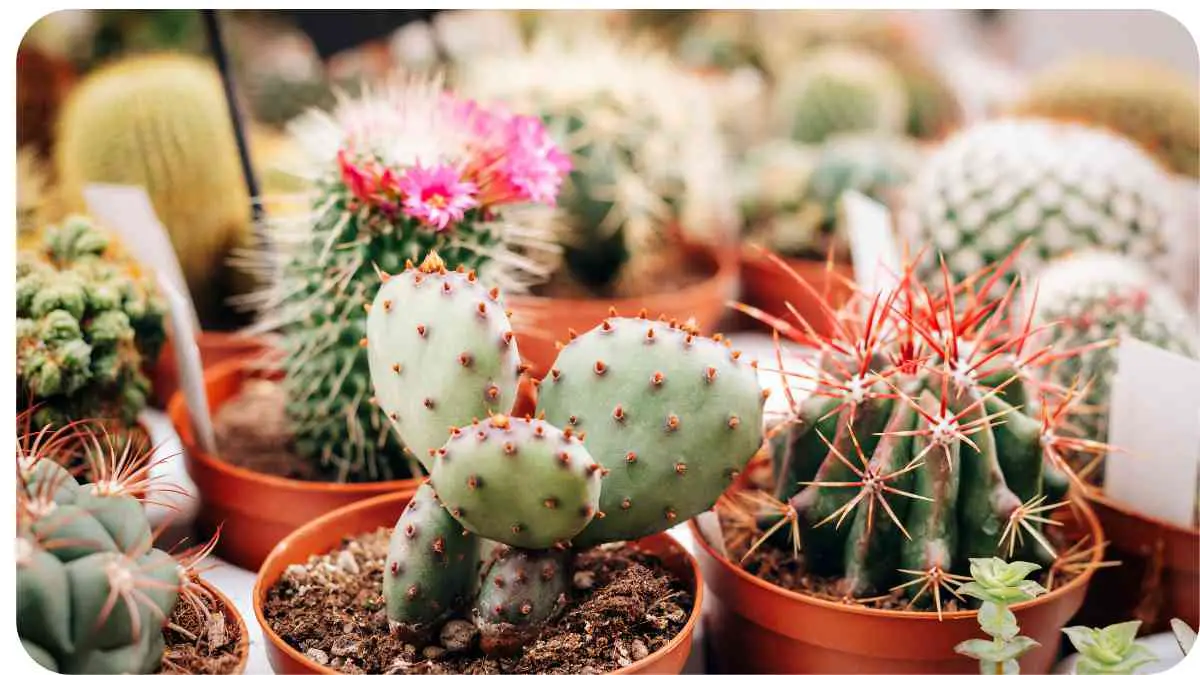Is your cactus looking a little sad and parched lately? It’s easy to assume that cacti, with their hardy nature and desert origins, don’t need much water. But figuring out the perfect watering routine for your prickly friend can be trickier than it seems.
Whether you’re a cactus newbie or a seasoned succulent lover, understanding how to properly hydrate your cactus is key to keeping it healthy and vibrant. So, what’s the deal with watering cacti? Why does it seem so complicated, and how can you troubleshoot common watering issues? Let’s dive in!
| Takeaway |
|---|
| Understand your cactus’s natural water needs to prevent both overwatering and underwatering. |
| Use well-draining soil and a pot with drainage holes to protect your cactus from root rot. |
| Adjust your watering schedule based on the season, humidity, and environment. |
| Monitor soil moisture regularly to ensure your cactus is hydrated but not waterlogged. |
| Bottom watering can help prevent water from sitting on the plant, reducing the risk of rot. |
| In high humidity environments, water your cactus less frequently to avoid water retention in the soil. |
| Use tools like moisture meters and watering apps to stay on top of your cactus’s watering needs. |
Understanding Cacti’s Water Needs

The Natural Habitat of Cacti
Cacti are native to some of the most arid environments on Earth, where rainfall is scarce and temperatures can soar. These desert conditions have shaped cacti into the resilient plants we know today, with a unique ability to store water and survive long periods of drought. But when we bring them into our homes, things get a little different. Our indoor environments, with controlled temperatures and artificial lighting, are far from the deserts of the Southwest or Mexico. This means that we need to adjust our watering practices to mimic their natural habitat as closely as possible.
How Cacti Store Water
Cacti are like little water tanks. Their thick, fleshy stems are designed to hold onto water for when times get tough. This ability to store water is what allows them to survive in the wild for months without rain. But in a home environment, this also means they don’t need to be watered as often as your typical houseplant. Overwatering is a much more common problem than underwatering, as it can lead to root rot and other issues.
Why Overwatering Is a Common Issue
One of the biggest mistakes people make with cacti is thinking they need more water than they actually do. It’s easy to fall into the trap of watering too frequently, especially if you’re used to caring for more traditional houseplants. But with cacti, less is often more. Overwatering can cause the roots to rot, leading to a sickly plant that may be beyond saving. Understanding when and how to water is crucial to keeping your cactus healthy.
Signs Your Cactus Is Parched

Visual Signs of Dehydration
How can you tell if your cactus is truly thirsty? A parched cactus often shows specific signs that indicate it’s in need of water. Look for shriveled or wrinkled skin, which is a telltale sign that the plant is using up its water reserves. Another indicator is the color of the cactus. If it starts to look dull or slightly brown, it might be time to give it a drink.
How to Check Soil Moisture
Before reaching for the watering can, it’s essential to check the soil’s moisture level. Stick your finger about an inch into the soil. If it feels completely dry, your cactus might need water. If it’s still slightly damp, hold off for a few more days. Using a moisture meter can also be a handy tool to get a more accurate reading.
Table: Symptoms of Underwatered vs. Overwatered Cacti
| Symptom | Underwatered Cactus | Overwatered Cactus |
|---|---|---|
| Appearance | Wrinkled, shriveled skin | Mushy or soft texture |
| Color | Dull, possibly brown | Yellowing or dark spots |
| Soil Condition | Completely dry | Wet, soggy, or moldy |
| Root Health | Dry, brittle roots | Rotting or blackened roots |
| Growth Rate | Stunted or no growth | Unusual, fast growth or none at all |
Common Watering Mistakes
Watering Too Frequently
It’s easy to get into a routine where you water your cactus on a set schedule. However, sticking to a strict watering routine without considering the plant’s actual needs can lead to problems. Cacti don’t follow a calendar; they react to their environment. So, watering once a week, no matter what, can often do more harm than good. Always check the soil moisture before watering.
Using the Wrong Type of Water
Believe it or not, the type of water you use can make a big difference. Tap water that’s high in minerals, such as calcium or chlorine, can build up in the soil over time, potentially harming your cactus. If possible, use rainwater or distilled water, which are free from these minerals.
Table: Best Practices for Watering Cacti
| Practice | Description |
|---|---|
| Check Soil Moisture | Always check soil moisture before watering; the top inch should be dry. |
| Water Deeply | Water until it runs out of the drainage holes, ensuring the roots are hydrated. |
| Use the Right Water | Opt for rainwater or distilled water to avoid mineral buildup. |
| Adjust Seasonally | Water less in winter when growth slows down. |
| Avoid Wetting the Body | Water the soil directly, not the cactus itself, to prevent rot. |
Choosing the Right Watering Schedule
How Often Should You Water Cacti?
Watering frequency depends on several factors, including the type of cactus, the size of the pot, the soil mix, and the environment. In general, most cacti need to be watered once every two to four weeks during the growing season (spring and summer). During the dormant period (fall and winter), watering should be reduced significantly, sometimes to just once a month or less.
Adjusting Watering Based on Season
Seasonal changes can significantly affect your cactus’s water needs. In the hotter months, cacti are actively growing and may need more frequent watering. But as the temperatures drop and sunlight decreases, their growth slows down, and so should your watering schedule.
Table: Seasonal Watering Guide for Cacti
| Season | Watering Frequency | Notes |
|---|---|---|
| Spring | Every 2-3 weeks | Increase frequency as temperatures rise. |
| Summer | Every 1-2 weeks | Monitor for faster drying soil. |
| Fall | Every 3-4 weeks | Begin to reduce watering as temperatures drop. |
| Winter | Once a month or less | Ensure soil dries completely between watering. |
Watering Techniques
Top Watering vs. Bottom Watering
When it comes to watering your cactus, there are two primary techniques: top watering and bottom watering. Top watering involves pouring water directly onto the soil from above, allowing it to soak down to the roots. This method is straightforward and effective but can sometimes lead to water collecting at the base of the cactus, which might cause rot.
Bottom watering, on the other hand, involves placing the pot in a shallow tray of water and allowing the soil to absorb the moisture from the bottom up. This method ensures that the roots get an even amount of water without soaking the plant itself. It also helps prevent overwatering, as the soil will only take in as much water as it needs.
Using a Drip Tray for Effective Watering
A drip tray can be a useful tool for both top and bottom watering. When using a drip tray, place it under the pot after watering to catch any excess water that drains out. This ensures that the roots don’t sit in water, which could lead to root rot. For bottom watering, fill the tray with water and let the pot sit for about 30 minutes to allow the soil to absorb the water.
Table: Comparison of Watering Techniques
| Technique | Advantages | Disadvantages |
|---|---|---|
| Top Watering | Quick and easy; good for larger pots. | Risk of overwatering; may cause rot if water collects at base. |
| Bottom Watering | Prevents water from sitting on the plant; ensures even moisture. | Takes longer; may not reach the surface roots. |
| Using a Drip Tray | Prevents waterlogging; allows for excess water drainage. | Requires monitoring; water can evaporate quickly. |
Soil and Pot Considerations
Importance of Well-Draining Soil
The type of soil you use for your cactus plays a significant role in its health. Cacti need well-draining soil to prevent their roots from sitting in water, which can lead to root rot. A typical cactus soil mix contains a combination of potting soil, sand, and perlite or pumice. This mix allows water to drain quickly while still holding enough moisture for the roots to absorb.
Choosing the Right Pot Size and Material
The pot you choose for your cactus is just as important as the soil. A pot that’s too large can retain too much moisture, leading to potential root rot. On the other hand, a pot that’s too small can restrict root growth and cause the plant to become root-bound. It’s also essential to choose a pot with drainage holes to allow excess water to escape. Materials like terracotta are excellent because they’re porous and allow the soil to dry out faster, which is beneficial for cacti.
Table: Recommended Soil Mixes for Cacti
| Soil Component | Percentage | Purpose |
|---|---|---|
| Potting Soil | 40% | Provides nutrients and basic structure. |
| Sand | 30% | Improves drainage and prevents compaction. |
| Perlite/Pumice | 30% | Enhances aeration and further improves drainage. |
Humidity and Its Impact on Cacti

How Humidity Affects Watering Needs
Cacti are accustomed to arid environments with low humidity, so when they’re placed in a more humid environment, their water needs can change. High humidity slows down the evaporation of water from the soil, meaning that you’ll need to water your cactus less frequently. Conversely, in very dry conditions, you might need to water a bit more often.
Adjusting Watering in High Humidity Environments
If you live in a region with high humidity, you’ll want to be extra cautious about overwatering. Always ensure the soil is completely dry before watering again, and consider placing your cactus in a well-ventilated area to help the soil dry out more quickly. If possible, keep your cactus in a room with a dehumidifier or a fan to reduce the humidity levels.
Table: Humidity Levels and Watering Frequency
| Humidity Level | Watering Frequency | Additional Tips |
|---|---|---|
| Low (0-30%) | Water slightly more often (every 1-2 weeks) | Monitor soil dryness more frequently. |
| Moderate (30-60%) | Standard watering schedule (every 2-3 weeks) | Ensure good airflow around the cactus. |
| High (60%+) | Water less often (every 3-4 weeks or more) | Use a fan or dehumidifier to reduce humidity. |
Identifying and Fixing Underwatering
Reviving a Dehydrated Cactus
If you suspect your cactus is suffering from underwatering, the good news is that it’s often easier to fix than overwatering. Start by giving your cactus a thorough watering, allowing water to run out of the drainage holes. If the soil is extremely dry, you might need to water it in stages, letting the water absorb slowly. Be patient cacti take time to rehydrate.
Long-Term Care for Recovering Cacti
Once your cactus is rehydrated, it’s essential to adjust your watering schedule to prevent it from becoming dehydrated again. Monitor the soil regularly and consider using a moisture meter to keep track of the soil’s moisture level. Additionally, ensure that your cactus is placed in a spot with plenty of sunlight, which will help it recover and thrive.
Table: Steps to Revive an Underwatered Cactus
| Step | Action | Purpose |
|---|---|---|
| Thorough Watering | Water deeply until water drains out. | Rehydrates the cactus and replenishes moisture. |
| Stage Watering | Water in stages if soil is extremely dry. | Allows for better absorption in very dry soil. |
| Monitor Moisture | Use a moisture meter to track soil moisture. | Prevents future dehydration. |
| Adjust Watering Schedule | Water more frequently, based on soil dryness. | Maintains proper hydration levels. |
| Increase Sunlight Exposure | Ensure the cactus gets adequate sunlight. | Helps in recovery and promotes growth. |
Preventing Future Watering Issues
Monitoring Soil Moisture Regularly
One of the best ways to prevent future watering issues is by keeping a close eye on your soil’s moisture levels. Regularly check the soil with your finger or a moisture meter, and water only when the top inch is completely dry. This simple habit can help you avoid both under- and overwatering.
Using Technology to Track Watering
There are several tools and gadgets available today that can help you stay on top of your cactus’s watering needs. Moisture meters, for example, can give you an accurate reading of how much water is in the soil, taking the guesswork out of watering. There are also apps that allow you to set watering reminders based on your specific plant’s needs.
Table: Tools for Monitoring Cactus Moisture
| Tool | Function | Benefits |
|---|---|---|
| Moisture Meter | Measures soil moisture level. | Provides accurate, real-time data. |
| Watering Apps | Sets reminders for watering schedules. | Helps maintain a consistent watering routine. |
| Soil Thermometer | Measures soil temperature. | Ensures the soil isn’t too cold or hot for watering. |
| Smart Planters | Monitors soil conditions and sends alerts. | Automates the care process for your cactus. |
Case Studies: Real-Life Cactus Watering Challenges
Success Stories from Cactus Enthusiasts
To wrap up, let’s look at some real-life examples from cactus enthusiasts who’ve faced and overcome watering challenges. Take John, for instance, who struggled with overwatering his cactus until he switched to bottom watering and started using a moisture meter. His cactus not only recovered but thrived, growing faster and stronger than ever before.
Then there’s Sarah, who lives in a humid environment and used to battle root rot. She learned to water her cactus less frequently and placed it in a well-ventilated area. The result? A healthy, happy cactus that’s now the centerpiece of her indoor garden.
Common Pitfalls and How to Avoid Them
While these success stories are inspiring, it’s important to acknowledge common pitfalls. Overwatering remains the number one mistake, followed closely by using the wrong type of soil. By sticking to the tips and techniques shared in this article, you can avoid these issues and keep your cactus looking its best.
Conclusion
Keeping your cactus healthy and hydrated doesn’t have to be a guessing game. By understanding its natural water needs, monitoring soil moisture, and adjusting your watering routine based on the season and environment, you can ensure that your cactus thrives. Remember, less is often more when it comes to watering these desert beauties.
Consistency is key. Whether you’re a cactus newbie or a seasoned enthusiast, the best way to keep your cactus healthy is by sticking to a routine that works. Don’t be afraid to adjust your methods as needed, and always keep learning your cactus will thank you for it!
Further Reading
- Lawn Care Proposal Guide: Learn how to create effective lawn care proposals to attract and retain clients, with detailed examples and templates.
- Diagnosing Cactus Problems: This guide helps you identify common issues with cacti and offers expert advice on how to address them.
- Why Is My Cactus Shriveling?: Discover the reasons behind shriveling and wrinkling in cacti and learn how to revive your plant with practical solutions.
FAQs
What should I do if my cactus is looking parched?
If your cactus appears parched, it likely needs water. Water it deeply, allowing the water to drain out of the bottom, and monitor the soil to ensure it dries out between watering.
How can I tell if my cactus is underwatered?
Signs of underwatering include shriveled or wrinkled skin, slow growth, and dry, compacted soil. Watering the cactus and adjusting your watering schedule can help.
Can I use regular potting soil for my cactus?
Regular potting soil retains too much moisture for cacti. It’s best to use a well-draining cactus or succulent soil mix that includes sand, perlite, or pumice.
Why is my cactus turning yellow?
Yellowing can be a sign of overwatering, poor drainage, or a lack of sunlight. Assess the watering schedule, ensure the soil drains well, and move the cactus to a sunnier spot if needed.
How do I prevent root rot in my cactus?
To prevent root rot, use well-draining soil, ensure your pot has drainage holes, and avoid overwatering. Let the soil dry out completely between waterings.

Hi! My name is Hellen James, and I’m a landscape designer in Los Angeles. I’ve been working with homeowners and businesses to help them improve the look of their properties for over 10 years.

